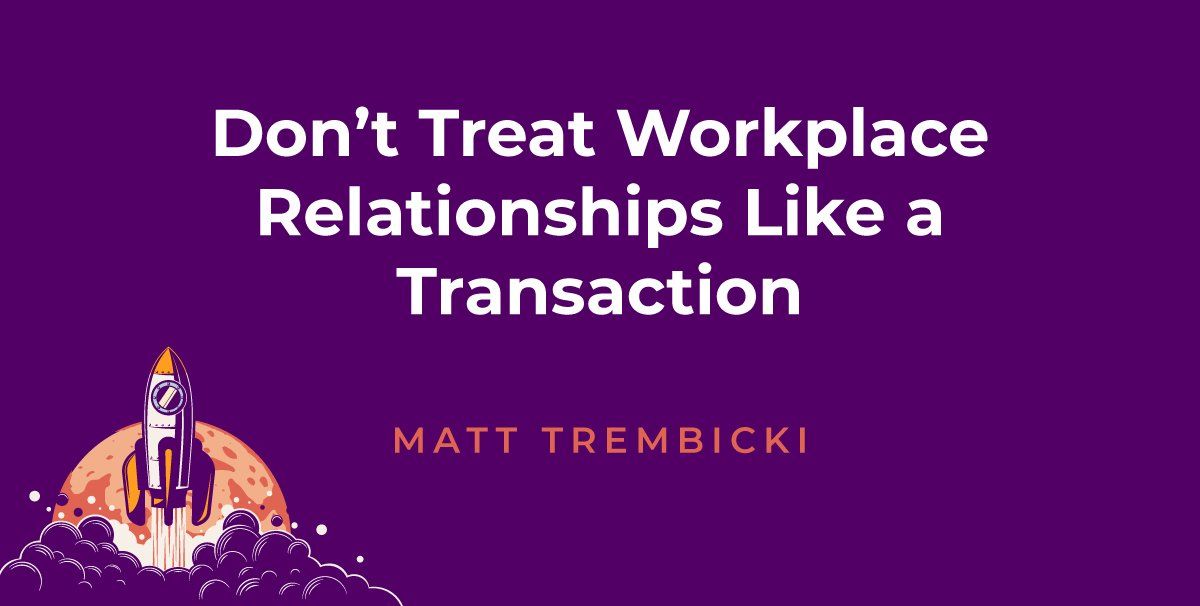Don’t Treat Workplace Relationships Like a Transaction
You’ve most likely heard of “transactional relationships” before, a term most often used to describe a situation when a married couple treats their marriage like it’s a business deal. The common consensus on this businesslike approach to marriage is that it is not wise. It also never seems to end well.
I also firmly believe that this same rule applies in the business world, meaning that you also shouldn’t treat corporate relationships like a business deal. But before you balk, keep reading. I promise my “why” is backed up by good reason.
What Is a Transactional Relationship?
Just as the name suggests, transactional relationships are all about transactions. Every transactional relationship is built around the paramount focus of answering the question: What are you giving me, and what am I expected to give you in exchange? Sounds harsh or at the very least a bit blunt, right? That’s because it is.
Why Should I Avoid Transactional Relationships in Consulting?
Now, you may be thinking, what’s the big deal, especially in the business world? Doesn’t it make sense for clients and the consultants they are hiring to be focused on the task at hand? After all, if I bring “X” to the table, then you bring “Y” to the table, then voila…
Well, yes, but really, no. We should be focused, but not so laser-focused on the “What am I getting out of it (and what am I having to give)” mentality that we lose sight of what else matters—which is plenty. Like what?
If all you ever discuss is the brass tacks and black and white expectations of your relationship, the precise and objective (quantifiable) end goal very may well get accomplished, but at what price? The cost may be achieving an outcome that involved very little personal conversation—if any—and most likely even less interpersonal connection (trust building, etc.) And with an approach like that, I’ve got to ask—and many clients may be left wondering—where’s the care?
Consultants Should Care
At AMPlify, our ethos is to truly care about our clients, and we think all consultants should. Consultants cannot implement meaningful change without understanding culture. Why? Because it is impossible to transform something without truly understanding it.
Consultants should be personable people, infinite learners, and team players. The most successful ones typically are, at least according to our fearless leader, Yashar Kafi, who provided even more characteristics of what makes a consultant truly shine in a recent article.
Successful Work Relationships Are Built on Mutual Trust
What else is missing in transactional relationships? Mutual trust. When you interact with someone just because of what you can get from them, it automatically creates an environment where there’s no natural trust. The other party is always operating from a mindset of what you are expecting from them and believes that is only what you care about. Essentially, each party begins to feel like the other party is the taker, and they are the givers—or worse, that they don´t really matter to the other party at all and are certainly not trusting that their best interests are being considered or looked out for.
Think about it this way: When someone constantly orders you around and shows no empathy or concern for you as a person—on a human level versus a solely business (transactional) level—it’s hard to want to do what they say and stay engaged. That’s just a tough pill to swallow, one that many won’t when it comes right down to it. People want to trust that they are being looked out for, and know that they matter. If they don’t experience or feel that in a relationship, it doesn’t bode well for the success of it, especially long-term.
Detached Employees Cost Employers Money
On a fiscal level, research shows that lack of care or engagement (detachment) hurts the bottom line, with studies showing how employee turnover costs employers money. According to peoplekeep.com, some studies estimate that each time a business has to replace a salaried employee, it costs 6 to 9 months’ salary on average.
Likewise, detached clients cost consultants money. So what can we learn from this? Simple: Detached and unengaged people in any work environment are bad news. To learn more, contact us today. We’ll get down to business together, without being all business.




